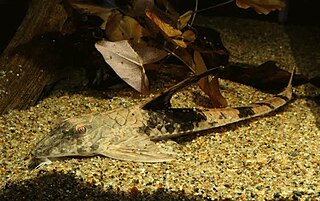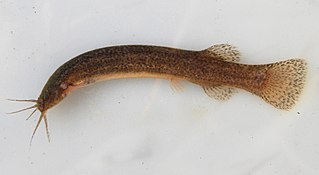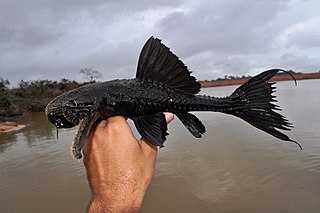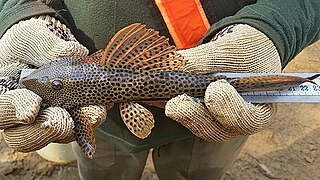
Loricariidae is the largest family of catfish, with 92 genera and just over 680 species. Loricariids originate from freshwater habitats of Costa Rica, Panama, and tropical and subtropical South America. These fish are noted for the bony plates covering their bodies and their suckermouths. Several genera are sold as "plecos", notably the suckermouth catfish, Hypostomus plecostomus, and are popular as aquarium fish.

Hypostomus is a genus of catfish in the family Loricariidae. They are native to tropical and subtropical South America. H. plecostomus is the popular freshwater aquarium fish formerly known as Plecostomus plecostomus. The taxonomic structure of the Loricariidae is still being expanded by scientists. Hypostomus is a highly species-rich and widely distributed catfish genus.

Acanthicus is a genus of large, South American suckermouth armored catfishes native to the Amazon and Orinoco basins, and possibly in Guyana. The name Acanthicus is derived from the Greek, akanthikos meaning thorny, spiny. Fish of this genus are known as lyre-tail plecos. These species are found in large rivers, primarily in areas with a rocky bottom and a moderate or strong current.

Rineloricaria is a genus of freshwater tropical catfish belonging to the family Loricariidae. They are commonly called whiptail catfish because of the long filament that grows out of the tip of the caudal fin that is characteristic of the genus. With the exception of R. altipinnis from Panama, they are native to the rivers of northern and central South America. Some species are regularly seen in the aquarium trade.

Peckoltia is a genus of small South American armored suckermouth catfishes. Many of these fish are popular aquarium fish.

Hemiancistrus is a genus of suckermouth armored catfishes. These species are native to South America. The taxonomy of this genus is complex and unclear, and major work has to be done. Many of these fish are popular aquarium fish.
Pareiorhina is a genus of armored catfishes native to South America where they are only found in Brazil. These species are known to occur at altitudes above 650 metres (2100 ft) in various rivers of the Grande, Paraíba do Sul, São Francisco and Tietê River basins. This genus was first erected by Gosline in 1947 as a monotypic genus to include Rhinelepis rudolphi. It was not until 2003 that a second species, P. carrancas, was described. The third species, P. brachyrhyncha was described in 2005. Pareiorhina forms a monophyletic subunit with Neoplecostomus within the subfamily Neoplecostominae.

Pseudacanthicus is a genus of medium to large-sized suckermouth armored catfishes native to South America, where found in the Amazon and Orinoco basins, as well as rivers of the Guianas. They are primarily found in fast-flowing waters, sometimes relatively deep. They are sometimes kept in aquariums.

Ituglanis is a genus of small freshwater fish in the family Trichomycteridae native to South America. Their greatest diversity seems to occur in the Amazon River basin. Most species inhabit leaf litter, with several species living in caves.

Acanthicus adonis, the adonis pleco or polka dot lyre-tail pleco, is a large species of armored catfish. It was originally described from the lower Tocantins River in Brazil, but individuals resembling the species have also been recorded from Amazonian Peru. The species is occasionally seen in the aquarium trade, but its massive adult size and territorially aggressive behavior means that a very large tank is required. These fish are opportunistic omnivores.

Acanthicus hystrix, the lyre-tail pleco, is a species of armored catfish native to the Amazon, Tocantins–Araguaia and Orinoco basins. It is typically found at various depths on a rock or rock–gravel bottom in the main channel of rivers in places with moderate to strong current, although it also occurs in slow currents. The species is occasionally seen in the aquarium trade, but its adult size and territorially aggressive behavior means that a very large tank is required.
Ancistrus saudades is a species of catfish in the family Loricariidae. It is native to South America, where it occurs in the basins of the Takutu River, the Ventuari River, the Caroní River, and the Caura River in Guyana, Venezuela, and Brazil. The species reaches at least 10.75 cm SL and was described in 2019 by Lesley S. de Souza of the Field Museum of Natural History, Donald C. Taphorn of the Royal Ontario Museum, and Jonathan Armbruster of Auburn University alongside five other species of Ancistrus. FishBase does not list this species.
Pseudacanthicus major is a species of catfish in the family Loricariidae. It is native to South America, where it occurs in the Tocantins River basin in Brazil. The species is notably large for a loricariid, reaching 60 cm SL.
Pseudacanthicus pirarara is a species of catfish in the family Loricariidae native to South America. It was described in 2016 by Carine C. Chamon of the Federal University of Tocantins and Leandro M. de Sousa of the Federal University of Pará, primarily on the basis of the species' unique coloration and patterning. Its specific epithet, pirarara, derives from a Tupi word meaning "macaw-fish", which is frequently used in Brazil to refer to the redtail catfish. It is known that P. pirarara is referred to as the assacu-pirarara by Brazilian fishermen, alluding both to its coloration and its spines, as assacu refers to the spine-covered tree Hura crepitans.
Scobinancistrus aureatus is a species of catfish in the family Loricariidae. It is native to South America, where it occurs in the Xingu River basin in Brazil. The species reaches 29 cm in total length.
Spectracanthicus immaculatus is a species of catfish in the family Loricariidae. It is native to South America, where it occurs in the Tapajós basin in Brazil. The species reaches 8.2 cm SL. Its specific epithet, immaculatus, is derived from a Latin word translating to "spotless", referring to the species' lack of any form of spotted patterning.
Spectracanthicus tocantinensis is a species of catfish in the family Loricariidae. It is native to South America, where it occurs in the lower Tocantins River in the state of Pará in Brazil. The species reaches 9.3 cm SL. Its specific epithet, tocantinensis, refers to its type locality, the Tocantins.

Aphanotorulus emarginatus is a species of catfish in the family Loricariidae. It is native to South America, where it occurs in the Amazon River basin. The species reaches 15 cm in total length. It is known to be a facultative air-breather.
Hypostomus delimai is a species of catfish in the family Loricariidae. It is native to South America, where it occurs in the basins of the Araguaia River and the Tocantins River in Brazil. It is typically found in areas with turbid water, riparian vegetation, and a substrate composed of rocks and sand. It is known to be sympatric with other species of Hypostomus, including H. faveolus and H. pyrineusi, as well as species of Aphanotorulus. The species reaches 25.3 cm in standard length and is believed to be a facultative air-breather.
Hypostomus faveolus is a species of catfish in the family Loricariidae. It is native to South America, where it occurs in the basins of the Tocantins River and the Xingu River in central Brazil. Adults of the species are typically found in both rapids and slow-flowing sections of medium to large rivers with varying substrates, although juveniles have been found in oxbow lakes and smaller streams. The species reaches 20.6 cm in standard length and is believed to be a facultative air-breather. Its specific epithet, faveolus, is derived from a Latin word meaning "honeycomb", referencing the honeycomb-like patterning exhibited by the species.










